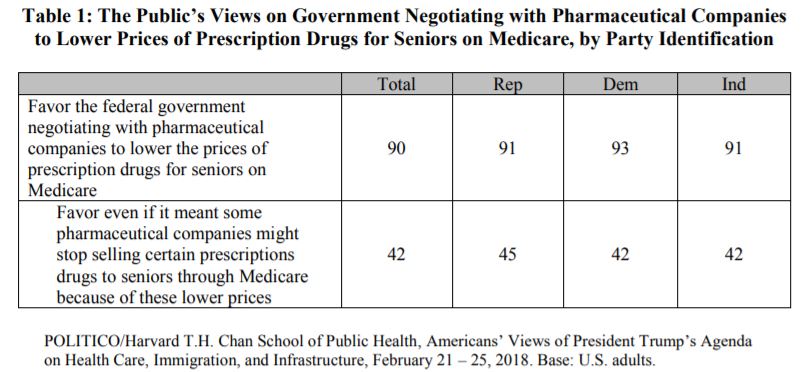The Medicare Negotiation and Competitive Licensing Act (H.R. 1046, S. 377)
Medicare Negotiation and Competitive Licensing Act two-pager (pdf)
While countries throughout the world reserve the right to negotiate with drug companies to achieve lower drug prices, current law prohibits the U.S. government from negotiating lower prices for the world’s largest purchaser of prescription drugs – Medicare Part D.
Nine in 10 Americans support the government negotiating lower prescription drug prices for Medicare Part D.[1] Empowering Medicare to negotiate the price of all drugs purchased under Part D could easily save $30 billion a year or more. The government and patients would have saved $14.4 billion in 2016 on the top 50 oral drugs alone if Medicare Part D prices matched those paid by the Department of Veterans Affairs, which does conduct price negotiations.[2]
What is the Medicare Negotiation and Competitive Licensing Act?
The Medicare Negotiation and Competitive Licensing Act would require the Secretary of Health and Human Services to negotiate prices for covered Medicare Part D drugs directly with pharmaceutical manufacturers.
What sets this bill apart from other Part D negotiation bills, is that when negotiations fail to arrive at an appropriate price[3], the Secretary would be required to issue a competitive license, authorizing generic competition by licensing use of patent, clinical trial data, and any other exclusivity granted by the federal government necessary for producing the drug. Competitive licensing is the only proposed approach to Medicare drug price negotiation that ensures patients’ access to medicine is not potentially at risk.
How does competitive licensing work?
Competitive licensing of patents is a mechanism that ensures patients will always be able to access the medicines they need. Patents are statutorily-created, narrowly-defined monopolies granted by the government. Since patent laws were created, governments around the world, including the United States, have preserved the right to use the patented technologies they protect. The Act would define conditions under which the Secretary uses patents through competitive licensing in the context of negotiating prescription drug prices for Medicare Part D, and ensure patent holders receive reasonable compensation.
What are the benefits of including competitive licensing as a fallback to Part D drug price negotiations?
Democrats, Republicans and Independents strongly support government negotiation of Part D drug prices, but this support weakens if patients are threatened with rationing:

The Veterans Health Administration and private insurers use a formulary as an alternative to competitive licensing. In practice, the formulary approach works for the VHA, but it is susceptible to the politically motivated argument that it would limit access to drugs.
The Medicare Negotiation and Competitive Licensing Act takes that opposition argument off the table. Rather than putting beneficiary access to a medicine they need at risk, it puts the monopoly of the drug corporation at risk. This approach provides the Secretary with strong leverage over negotiations to help arrive at a reasonable price while protecting patients’ access to medicines. This is a major feature relative to other Part D negotiation bills, both substantively and politically.
The leverage provided to the Secretary in conducting negotiations with a backstop of competitive licensing would compel drug corporations to deliver substantially lower prices, and in the instance where a competitive license is issued, generic competition would bring prices down to a fraction of that of the brand name product.
What about innovation?
The Medicare Negotiation and Competitive Licensing Act protects and better aligns incentives for innovation. By requiring the Secretary to consider the cost effectiveness and comparative effectiveness of prescription drugs in price negotiations, the Act rewards genuine therapeutic advances and better aligns incentives for meaningful innovation. If negotiations failed, the company would still receive compensation based in part on the risks and costs of research and development and the health benefits of the medicine. R&D estimates frequently cited by industry groups to justify high prices are drawn from studies funded by industry that use secret data, rely on assumptions that do not withstand scrutiny, and are inconsistent with other findings.[4] Public funding also plays a pivotal role in driving innovation. Industry directly builds on the knowledge base funded by the public. National Institutes of Health-funded research was associated with every one of the 210 new drugs approved by the Food and Drug Administration from 2010–2016.[5]
What if a drug company spikes its price before a generic is available?
In the case that a license is triggered, while waiting for competition to come online, the Act would provide an interim ceiling price based on an international reference price. For enforcement, if a company refuses to sell at the reference price, the license would be expanded to cover sale to all federal programs rather than only Medicare Part D.
[1] Politico/Harvard T.H. Chan School of Public Health. President Trump’s Agenda on Health Care, Immigration, and Infrastructure (March 2018) https://tinyurl.com/y64z2uaj
[2] B Venker, PharmD; K.B. Stephenson, MD; W.F. Gellad, MD, MPH; Assessment of Spending in Medicare Part D If Medication Prices From the Department of Veterans Affairs Were Used; JAMA Internal Medicine (2019), https://tinyurl.com/y4vnxzol
[3] Whether a price is an appropriate is determined by the Secretary with consideration for factors enumerated in the bill, including comparative effectiveness research, the budgetary impact of providing coverage of the drug, the financial burden on beneficiaries utilizing the drug, and others.
[4] Almashat, S. “Pharmaceutical Research Costs: The Myth of the $2.6 Billion Pill,” Health Letter. September 2017. https://tinyurl.com/y4kb4xoq
[5] Cleary E et al., “Contribution of NIH funding to new drug approvals 2010–2016,” PNAS: Vol. 115: Iss. 10. https://tinyurl.com/yxu2alfb